Opel Insignia 2008. – 2017. – polovnjak, experiences, problems
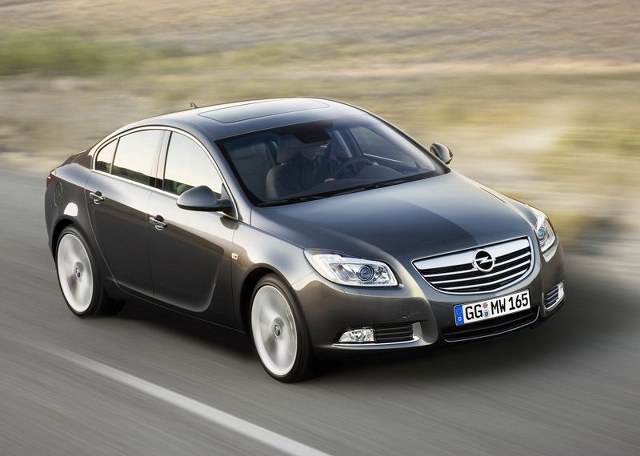
Opel Insignia
Dok je prva i, especially, druga generacija Vectre bila najpopularnija vozila među vozačima, model treće generacije je bio nešto drugačiji, pogotovo u poređenju sa trenutnom konkurencijom. Opelu je trebalo nešto novo, nešto što bi opet značajno oživilo interesovanje kupaca vozila srednje klase. Dizajneri Opel nisu ništa prepustili slučajnosti i svetu ponudili sportsku opremu i modernom tehnologijom opremljenu Opel Insigniju. Napor nije bio uzaludan, što je dokazano i naslovom evropskog automobila 2009.
Vozne karakteristike Opel Insignije su na pristojnom nivou, što u praksi znači dovoljno sigurnosti i sigurna kontrola vozila čak i pri bržoj vožnji. However, nije potrebno da se brzo vozi, jer je Opel Insignia prilično težak automobil, u i oštrim krivinama počinje da se pojavljuje podupravljanje. Iako u tim situacijama efekasno pomaže ESP sistema, ali u nekim situacijama je nemoćan i ESP. Masivna masa vozila takođe se može osetiti kada se Opel Insignia naglo menja, sa teškim diesterom ili super-punjenim šestocilindričnim benzinom ispod haube.
Engines – Opel Insignia
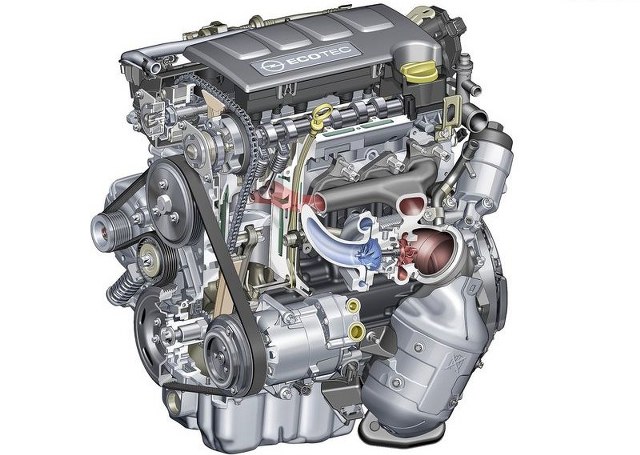
Opel Insignia 1.6 16V i Opel Insignia 1.8 16V
Insignia će vas zadovoljiti dobrim izborom motora. Benzinska baza je sastavljena od dva poznata motora 1.6 litara i 1.8 l , snage 85 KW (155 Nm), odnosno 103 KW (175 Nm). Oba motora su uzeta iz modela Vectra C i prošla su značajnu modernizaciju. Glavne tehničke inovacije uključuju varijabilan razvod ventila, variable cevi usisa sa promenjivom dužinom (sa rotacionim poklopcem umesto ventilom) i novim senzorom radilice. Varijabilno vreme otvaranja ventila se reguliše pomoću elektrohidrauličkog aktuatora. Bregasta usisnih ventila se rotira za 60 °, vratilo izduvnih ventila rotira za 45°. Promenljiva vreme otvarnja usisnih i izduvnih ventila optimizuje punjenje i pražnjenje komora za sagorevanje u svim režimima vožnje. Motori u odnosu na prethodnika pokazuju bolju obrtni moment u širem opsegu obrtaja, nižu emisiju izduvnih gasova, manju potrošnju goriva i manju buku.
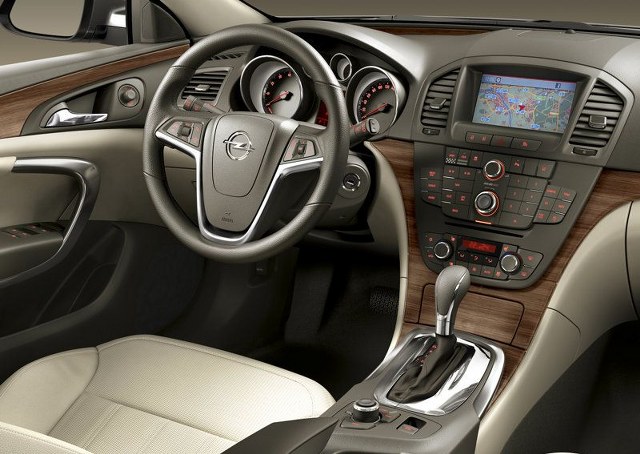
U praksi, oba motora karakterišu kultivisani i tihi rad, a pouzdanost je takođe veća. Slabiji 1.6 16V (A16XER) u skladu sa svojom dinamikom je za manje zahtevne vozače za pretežno kraća putovanja. Manjak snage se manifestuje naročito kod preticanja pri većim brzinama ili kada se u vozilu vozi više ljudi. Što se potrošnje tiče ona je oko 7.5 do 8 l, česta vožnja po gradu ili brza vožnja autoputom, mogu podići potrošnju do 9 l. A malo bolje dinamiku naročito pri manjim brzinama motora obezbeđuje motor 1.8 16V (A18CER), dok je potrošnja od 1,6 motora malo veći, i u prosek je oko 8 l.
Opel Insignia 1,4 Turbo
Osnovni benzinski turbo motor je četvorocilindrični 1.4 Turbo snage 103 KW i obrtnog momenta od 200 Nm. Uživajte u kultivisanoj vožnji i dobroj zvučnoj izolaciji. Kod manjeg broja obrtaja motora, snaga motora je mala. Snaga motora postepeno raste, snaga dolazi iznad 2000 O / me, a puna snaga motor je iznad 3000 O / me. Potrošnja u velikoj meri zavisi od opterećenja motora – dinamike vožnje. Pri mirnijoj vožnji može se postići potrošnja od oko 7 l, ali u praksi je prosek oko 8,5 l. Dinamična vožnja znači potrošnju od 10 ili više litara.
Opel Insignia 1.6 Turbo
Još jedan benzinski motor sa turbopunjačem u ponudi je četvorocilindarski 1.6 sa max. snagom od 132 KW i obrtnim momentom od 230 Nm. Motor obavlja veoma dobro posao u modelima kao što Astra ili Corsa, ali u skoro pet metara dugoj i teškoj oko 1,6 tona Insigniji 1,6 turbo motor se pokazao znatno lošije. Ovo se naročito odnosi na manje obrtaje motora. Motor oživljava na oko 1600 rpm, a značajniji deo dinamike dolazi posle 3000 rpm. Na većim obrtajima motor nema problema, a putnici će takođe uživati u sportskom zvuku. Nedostatak je u tome što potrošnja u velikoj meri zavisi od opterećenja motora.Pri ekonomičnojoj vožnji potrošnja je u proseku oko osam litara, realni oko 9 l, tokom dinamične vožnje potrošnja ide i do oko 12-15 l. Takođe treba napomenuti da dva motora (1.4 Turbo i 1.6 turbo) najbolje rade sa benzinom sa većim oktanski broj (98 ili više). Sa običnim benzinom, motor takođe radi, elektronika reguliše proces sagorevanja, a rezultujuća dinamička performansa je nešto slabija.
Opel Insignia 1.6 SIDI Turbo
1,6-litarski četvorocilindrični turbo motor zamenio je 1,6 litarski turbo SIDI (Spark Ignition Direct Injection) sa izlaznom snagom od 125 KW, odnosno 147 KW i obrtnim momentom od 260 Nm odnosno 280 Nm. Njegov dizajn, dve verzije skoro identične, razlike su drugačija turbina i viši nivo pritiska u turbini kod moćnije verzije, slabija verzija, on the other side, veći stepen kompresije od 10,5: 1 umesto 9,5: 1 kod jače verzije. Različit je, course, motorni pogon i zbog različitog odnosa kompresije, manja podešavanja dotakla su prostor sagorevanja. Oba motora imaju blok livenog gvožđa blok, aluminijumska glava motora sa varijabilnom otvaranjem svih ventila, izduvni ventili rade u dvostepenom varijabilnom hodu, koji pruža bolje pražnjenje komore za sagorevanje. Turbo punjač se u obe verzije hladi rashladnom tečnošću, prefinjenost poboljšava par bilans vratila koji rotiraju pogonjenih posebnim lancem. Pogon motora je preko lanca.
Potrošnja je slična manjem 1.4 turbo motoru, u velikoj meri zavisnosti od stila vožnje, ali je oko 8.5 l, pri ekonomičnijoj vožnji potrošnja je oko 7 litara sa druge strane penje se do 10 litara pri bržoj vožnji autoputem ili pri čestoj vožnji po gradu. Čak i za ovaj motor važi da je bolje sipati benzin sa više oktana, ne samo u pogledu dinamike vožnje, već i zbog dužeg životnog veka – manje skupljanje opasnih naslaga u motru .
Opel Insignia 2.0 Turbo
2.0-litarski motor sa turbo punjačem i sa 162 KW i obrtnim momentom od 350 Nm. Osim direktnog ubrizgavanja benzina, motor je opremljen sa varijabilnim otvaranjem usisnih i izduvnih ventila. Izduvni kanali su odvojeni zasebno za spoljne i unutrašnje cilindre i spajaju se blizu turbopunjača. Motor zadovoljava u širokom opsegu korisne brzina i ima puno snage čak i pri manjim obrtima. Najbolja dinamika ima oko 3000 rpm, uz blagi pad dinamike koja počinje nakon 5000 rpm. Potrošnja je opet u velikoj meri zavisna od opterećenja motora, mada manje značajno od manjih 1.4 i 1.6 Turbo. Ovo je uglavnom zbog značajno veće sile pri manjim obrtanjima i manju potrebu za čestim promenama brzina. Uz malo truda moguća je efikasna vožnja sa prosečnom potrošnjom goriva od oko 9 l / 100 km. However, sa dinamičnijom vožnjom potrošnja je oko 11-12 l, sa teškom nogom ide i do 15 litara i više benzina. Kao i u slučaju manjih 1,4 Turbo i 1,6 Turbo, preporučuje se korišćenje 98 oktanskog benzina ili visokokvalitetnih aditiva. Više oktanski benzin u velikoj meri eliminiše formiranje naslaga na usisnim ventilima i samom motoru, čemu je motor sa direktnim ubrizgavanjem skloniji.
Opel Insignia 2.8 Turbo V6
Vrhunski i veoma retki benzinski turbo aluminijumski motor 2,8 Turbo V6, koji dostigne 191 KW i obrtnim momentom od 400 Nm u širokom opsegu brzina (1900- 4500 rpm). Cilindri su pod uglom od 60 stepeni. Motor je opremljen varjabilnom regulaciom usisnih ventila i uključuje posebne vodove za svaki red cilindara koji se spajaju neposredno pre turbopunjača. Oni obezbeđuju brzu reakciju i dovoljan obrtni moment od najnižih obrtaja motora. U praksi, motor zaista ima dovoljno snage za brzu dinamičnu vožnju bez obzira na to koliko ljudi ili prtljaga je u kolima. Motor će takođe ima u veoma kultivisanom i tihom radu. However, nedostatak je veći operativni trošak. Namely, potrošnja ispod 10 litara će biti samo u veoma mirnoj vožnji, realnost je negde oko 12 do 13 l, češća vožnja u gradu ili brza vožnja po autoputu i potrošnja ide iznad 15 l.
Opel Insignia OPC
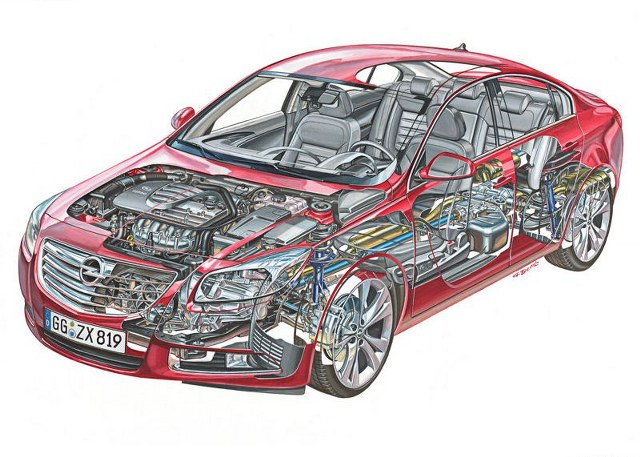
Opel Insignia
Opel Insignia – Diesel engines
Opel Insignia 2.0 CDTi
Opel Insignia 1.6 CDTi
Opel Insignia – Troubleshooting problems
Opel Insignia Servis
| Tip karoserije: | limuzina/ 4-vrata | sedan / 5-doors | caravan / 5-doors (Sports Tourer) |
|---|---|---|---|
| Dimensions (D x Š x V v mm): | 4830-4842 x 1856 x 1498 | 4830-4842 x 1856 x 1498 | 4908-4913 x 1856 x 1520 |
wheelbase (mm): | 2737 | 2737 | 2737 |
| Prostor za prtljag (l): | 500 | 520 | 540/1530 |
| Pogon: | Prednji pogon / 4×4 | Prednji pogon / 4×4 | Prednji pogon / 4×4 |
| Zapremina rezervoara goriva (l): | 70 | 70 | 70 |
Opel Insignia motori
| Motor | Volume | Kodovi motora | power |
|---|---|---|---|
| 1.4 | 1364 CCM | A 14 NET | 103 kW |
| 1.4 LPG | 1364 CCM | A 14 NET | 103 kW |
| 1.6 | 1598 CCM | A 16 XER | 85 kW |
| 1.6 SIDI | 1598 CCM | A 16 XHT | 125 kW |
| 1.6 Turbo | 1598 CCM | A 16 LET | 132 kW |
| 1.8 | 1796 CCM | A 18 XER | 103 kW |
| 2.0 E85 Turbo | 1998 CCM | A 20 NHT | 162 kW |
| 2.0 Turbo | 1998 CCM | A 20 NHT | 162 kW |
| 2.0 Turbo | 1998 CCM | A 20 NHT | 184 kW |
| 2.0 Turbo 4×4 | 1998 CCM | A 20 NHT | 162 kW |
| 2.0 Turbo 4×4 | 1998 CCM | A 20 NFT | 184 kW |
| 2.0 Turbo E85 | 1998 CCM | A 20 NHT | 162 kW |
| 2.8 V6 Turbo 4×4 | 2792 CCM | A 28 NET | 191 kW |
| 2.8 V6 Turbo OPC 4×4 | 2792 CCM | A 28 NER | 239 kW |
| Motor | Volume | Kodovi motora | power |
| 2.0 Biturbo CDTI | 1956 CCM | A 20 DTR | 140 kW |
| 2.0 Biturbo CDTI | 1956 CCM | A 20 DTR | 143 kW |
| 2.0 Biturbo CDTI 4×4 | 1956 CCM | A 20 DTR | 140 kW |
| 2.0 Biturbo CDTI 4×4 | 1956 CCM | A 20 DTR | 143 kW |
| 2.0 CDTI | 1956 CCM | A 20 DTC,A 20 DTL | 81 kW |
| 2.0 CDTI | 1956 CCM | A 20 DTE | 88 kW |
| 2.0 CDTI | 1956 CCM | A 20 DTJ,A 20 DT | 96 kW |
| 2.0 CDTI | 1956 CCM | A 20 DTE | 103 kW |
| 2.0 CDTI | 1956 CCM | A 20 DTH | 118 kW |
| 2.0 CDTI | 1956 CCM | A 20 DTH | 120 kW |
| 2.0 CDTI 4×4 | 1956 CCM | A 20 DTH | 118 kW |
| 2.0 CDTI 4×4 | 1956 CCM | A 20 DTH | 120 kW |
Opel Insignia cena – pregled polovnjaka

Hi there, I am Mladen and I am an auto enthusiast. I started this blog years ago to help like minded people share information about latest cars, car servicing ideas, used car info, exotic cars, and auto technology. You will find helpful articles and videos on a wide variety of cars – Audi, Mercedes, Toyota, Porsche, Volvo, BMW and much more. Ping us if you have anything cool to share on latest cars or on how to make older cars more efficient, or just want to say hi!


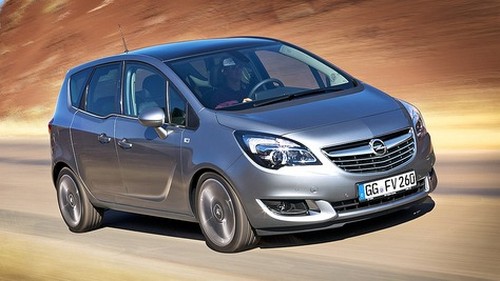
Dobar dan, imam problem sa Insignijom, kad upalim auto, upali mi se lampica za ulje, da zaustavim motor, i posle par sekundi se ugasi, auto ne gubi snagu, nista se ne desava sa njim, u toku voznje se ne pali lampica, sve funkcionise normalno, nivo ulja na meracu je na maksimumu, ne znam koji je problem??
Odmah zameni gumicu (2000 dinara) na uljanoj pumpi, inače će ti napraviti štetu na motoru do 800 euros!!
Pozdrav!
Pozz koji motor je u Vašoj insigniji, da li je istina da motori sa 130 konja manje imaju kvarova nego ovo sa 160
Isti problem imam,jestel vi saznali sta je upitanju
Odmah, hitno zamenite gumicu (2000 dinara) između Kartera i bloka, inače će ti napraviti štetu na motoru do 800 euros!!
Pozdrav!
Insignia 2010,2.0 cdti.
Na kompu ne pokazuje predvidjenu kilometrazu sa trenutnim gorivom. Nece da se resetuje, a na dijagnostici ne pokazuje nikakvu gresku. Zna li neko sta moze da bude problem?
Postovani imam isto problem sa Insigniom i to tako sto kad je upalim malo zatrese sva i prestane kd pocnem da vozim jednostavno pocne kompletno auto da se tresse i onda zablokira sve i volan i mjenjac i gas i kocnica, tada zovem adac i pni dpdju ugase ga preko diagnostike. Kad je prikljuce na diagnostiku nikad nista ne pokaze ni jednu gresku sve po ps u. Vose puta zamenjene svjecice i jos bruku drugih stvari koje nisu doprinjele nicemu. Preko 4000€ dala na popravke bez ikkve koristi i 7 majstora koji ne znaju sta je problem. Sve je pocelo kd sam se vracala iz bosne i nakon godisnjeg 10 dana jednostavno auto je stalo. Tad su mi rekli da je voda u rezervoaru onda je to Opel auto kuca sve sredila po njihpvoj prici je auto ok. Poslije tog kvara mjesec dana sve ostalo je pocelo mislim samo tak probelm koji niko ne zna zasto tako trese i sve zablokira i onda se mora ugasit. Postoji li mogucnost da su oni u servise prilikom ciscenja rezervoara sta ostezili ili… ???
Radi se o Opel Insignie 70.000km presla , 12.2014 godiste , turbo benzin 1.6-125kw
Problem sa dugim svetlima I amblend svetlo. Pokazuje se na tabli, AFL servis. Kako da to otklonim
Da li neko zan kakvi su motori 2.0 143 kw, odnosno bi-turbo
Zadnji desni podizac stakla otkazao, nakon par dana i prednji pa i zadnji levi? Imao neko takav problem, majstor poskidao desna 2 radili jedan dan i opet isto.
nestaje tecnost iz emulzione posude a kompjuter nista ne signalizira.dosipao sam 3 litra.dali je opasno da toliko tecnosti iscuri za 3 meseca kolko je proslo od remonta?